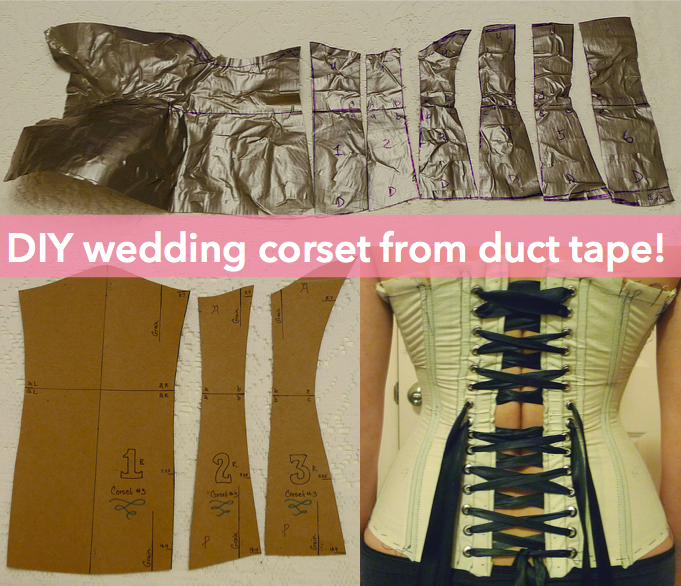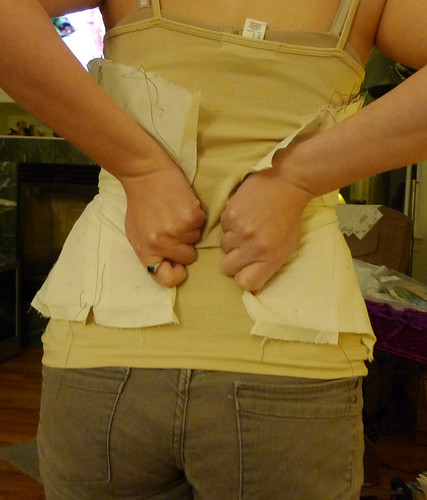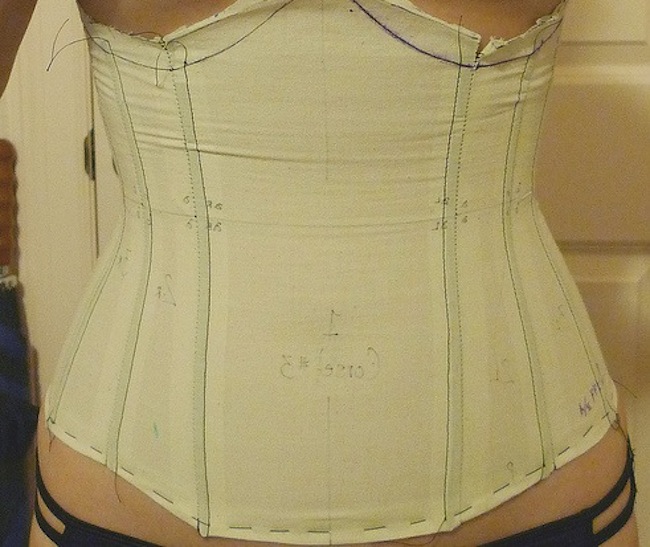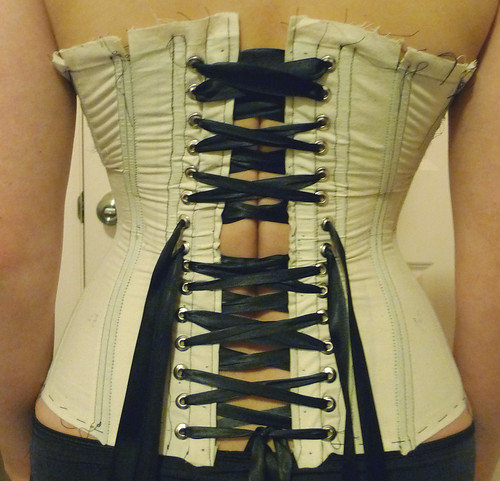
I decided to make my own corset for a combination of reasons. Foremost, while my horizontal measurements are pretty average, my vertical ones are not (read: I'm a shortie). This means that standard corsets jab me in the armpits constantly. I also didn't have the $250-600 to indulge in a custom made corset. So of course, it was off to DIY!
It is completely possible to buy a pattern to make a corset for yourself, but if you have non-standard measurements, there is a decent chance that the pattern will require a high amount of alteration anyway.
So why not just make a completely custom corset pattern, fitted exactly to you, with duct tape?
I did, and it has been awesome, even for me as a beginner. I followed this fabulous youtube tutorial series from Lucy of Lucy's Corsetry.
Even though this is a pretty darn thorough series, it's hard to cover EVERYTHING, so that is why I've written this post. To fill in gaps, to talk about the experience of going through the tutorial, and to generally share everything I learned!
Making the duct tape model:
- Making the duct tape form with my partner was surprisingly sexy. Bralessness + groping opportunities = yay!
- The duct tape tends to peel away from the shirt once you've cut them both off your body. We had to peel off the shirt, and add duct tape to the back of the first duct tape layer, to keep it from sticking to itself and everything else.
- Listen to Lucy: do not forget to mark center front, center back, and the waistline on your duct tape form! The waist line is especially important during pattern making.
The Duct Tape Pattern:
Step 1: The videos do not offer that much guidance on deciding how to divide the duct tape form into pattern pieces. I understand why — there are an infinite number of ways to go about patterning a corset! Still, I was a little lost about how many pieces to cut, whether they should be cut on a bias, how to pin or stitch them, whether they should be equally sized or uneven, how they should be shaped, etc. so:
- I decided to make my panels nearly even in width just for simplicity. This is very functional and looks good, but it is not as beautiful as the seaming in some corsets.
- I decided on six panels to each half of the corset, because error increases with the number of pattern pieces (and error piles up over 10+ slender pieces of fabric!). I wanted enough panels for serious rigidity, but not so many that my modest sewing skills would be overwhelmed.
- I tested different seam shapes by drawing on the form with sharpies and “erasing” with rubbing alcohol, until I found something I liked.

Creating the Paper Pattern:
Step 1: Get ready to go through a couple drafts of patterns. After tracing the duct tape pattern pieces onto paper, you have to decide how much you want the corset to reduce your horizontal dimensions and how wide you want your lacing gap, then subtract these amounts over your many pattern pieces. Mistakes are inevitable and fabric behaves differently from duct tape, so test, test, test!
Step 2: Buy your boning, grommets, grommet setter, and laces now, so that you'll have them by the time you're ready to make a final, boned muslin. I invested in laces made specially for corsets after watching my sister's bridesmaids struggle with her random yards of ribbon from the fabric store — they got burned hands and the stuff broke twice!
Step 2.5: Make a pattern of your original duct tape pieces with no reduction. This way, if your first reduced pattern doesn't work, you won't have to trace the actual duct tape again (a finicky job), but can use this un-altered pattern.
Step 3: Remember, even if you don't want the corset to reduce your hips or underbust/bust, you still need to take width off these areas so that there will be a lacing gap in the back.
Step 4: Corsets seem to work the opposite of most garments; it's better to make them slightly too small than slightly too big. (I'm talking a little bit, here. It is possible to have a too-small corset!) You can allow a wider lacing gap if it's too small, or pull the laces a bit tighter, but if the corset is too big, the back panels start to touch and you can't tighten the laces any further. So don't bother being cautious when deciding on your waist reduction and the width of the lacing gap. I took a full six inches off the waist — two for the lacing gap, and four for the actual reduction, even though I only intend to pull the corset tight enough to reduce myself by two inches. Funny thing is, the corset fits better this way!
Step 4.5: If you're going for a big waist reduction (more than five inches), you will need space for that flesh to move to, so make your underbust and hip measurements roomy!
Step 4.75: Record your alterations. You may go through several patterns; chances are you won't remember exactly what you did each time.
Step 5: Notate the fuck out of your pattern pieces! Number them and mark so that you know how they join. Use a line perpendicular to the waistline as your fabric grain line. Proper notation saved me so much hassle!

Muslin Making:
Step 1: You only need to make one “copy” of your pattern in muslin per fitting. If you're using the sandwich construction method on the final corset, you will eventually need to make two “copies,” and sandwich the boning between them. There is no need to make both copies at this stage, though, since you'll likely be adjusting anyway.
Step 2: You will need to lace up somehow in order to alter the fit. As I learned, it's really hard to see what needs to be done if you're just holding it together behind your back. I just marked spots and used thread to lace in the early stages when I was looking at the general fit. Once I got to the boned muslin, I put in grommets and lacing because I wanted to really perfect the fit, and I needed to be able to really lace up tight to do that.
Step 3: For the boned muslin, I made the boning channels by pressing open the seams and sewing one side down to make the channel. I will not do this in the final corset! Is only for fitting purposes! I used zip ties as mock-bones for all the ones that would be spiral steel, but I used the actual white spring steel ones for the last two channels (to get a good idea of the final rigidity). I used some crappy grommets I had lying around so that we could really pull the laces taught without ripping holes in the fabric.

Muslin Review:

Muslin One: I am holding the back edges tight and parallel behind by back. You can see how big this thing is in the hip and underbust at this point, since I forgot to reduce them by the amount of the lacing gap.

Muslin One again.: Freakin' huge, even in the waist.

Muslin Two: Better, but the underbust is too high (though not by that much – the corset had shifted up on my waist. The black marks at the bottom edge show how much width I could take out of the hip (3.5 cm on each side).

Muslin Two: Had problems with the fabric folding under pressure at the sides and back. At the time, I was super worried that the final corset would also have this problem, but it turned out that boning fixed everything. This was good, as I like to bone.

Muslin Two: The top and bottom edges look parallel, but they aren't evenly tightened. If they were evenly tight, they would have been all wonky angles. I couldn't pull in the waist properly without boning in, but it looked about right.

Muslin Three: Purty! I tried this on without boning or interfacing and it fit pretty well, so I basted the bottom edge (sewed the seam loosely) and put in boning. It fits fucking great.

Muslin Three back view: The lacing gap is pretty small, but that's okay. The edges of the gap are nearly parallel, which is awesome. I am satisfied enough to move to the final fabric!! Also, holy venus fold, batman!
So that's that! I don't claim to be any sort of expert, this is just what I gleaned from the experience. The whole pattern making and fitting process took ~2 weeks of working on it every other night. I left nights in between because muslin making can be frustrating – it sucks when you've spent all this time making a new pattern and sewing a new muslin and it still doesn't work!
Overall, though, it wasn't that difficult. I'm not even an intermediate sewist and I could do this. I should note that, like many DIY projects, it wasn't actually cheap, just cheaper than the alternative (I'm at ~$110 on corset materials, tools, and cotton / canvas fabric, and thread). Still, I would definitely encourage people to give this a try – it is, somewhat ironically given the nature of a corset, freeing!







wow – way cool! I really like seeing all your various stages…tutorials so often show just the really good stuff, and then I get frustrated when it takes me 10 extra steps to go from ugly to nice. I hope we get to see a photo of your final corset!
I did something similar to this, I wouldn’t do it again or recommend it. The duct tape process was a horrid sticky business that ruined a pair of scissors and ended up really only providing a vague starting point that left me in a similar position to how I would have been with a purchased pattern.
Huh. We had very different experiences! The duct tape part was non-problematic for me and my partner. We neither ruined scissors nor had much of a problem with the stickiness – perhaps because it was a team effort? I could see it being a giant pain in the ass if you were doing it single handed. Also, if your scissors get sticky, all you need is some nail polish remover or rubbing alcohol to de-gunk them.
As to it being simpler to just buy a pattern, that may be the case if you have standard measurements. However, if you’re a non-standard shape and can’t afford a specially drafted pattern, a commercial pattern may also be an equally vague starting point.
For others wondering which way to go, you can weigh the $5 and 2 hours to make a duct tape form against the $20 (for a decent pattern) and shipping/getting-to-the-store time for a pre-made pattern. There is also experience to be considered. For me, it was also worth it to do the duct tape because I’m on a larger mission to improve my sewing skills, and part of that is better understand pattern-making and fit. I don’t want to be limited in my creations by the patterns that are available on the market!
For even more information on pattern making vs. buying, one of Lucy’s videos addresses this! See: http://www.youtube.com/watch?v=f2JwbXexfmQ
Thanks, very helpful information.
I made a corset from a pattern on the internet. It required some tweaking to get it to fit (the modifications they recommended for different bust sizes were semi-insane), and it looked and fit great until I tightened it significantly and left it on for a while. It totally threw out my (already compromised, its true) back, cause it pulled the bend out of my lower spine. I think I can use it to create a different pattern, but I also think I might just pay a professional. Back pain is not worth it. Just something to be aware of.
and on a totally different note, rather than buy boning before I was sure of the lengths I needed (and have to wait for them to arrive) I taped four pin flag (the kind they use to mark underground pipes and such) wires with the flags cut off together flat with masking tape for each piece of boning. It worked really well.. In the long run, I would want to replace them to prevent rust staining, but it was great for getting the lengths right, and would work as long as the corset didn’t get wet. With shrink tubing it could even be permanent.
Oh, ack! I have never had back problems, so I didn’t realize this could be an issue. Thanks for the heads-up!
As to the boning, I applaud your creativity! I was also nervous about ordering pre-cut lengths of boning, so I ordered a roll of uncut spiral boning.
honestly? It had very little to do with nervousness over lengths, and quite a bit to do with the “but I want to start now” issue. The end result was excellent, and very comparable to any other steel boning though. Really cheep, too.
I love this idea, as I am fan of corsets for actually giving me a shape (other than pear) and serious assist my poor posture. I can sew reasonably well, but access to boning, and sewing accessories is extremely limited in my area(postage costs alone would be more than a custom made job). I like how your post highlights trial and error, most people never get everything perfect first time around, but each trial will have something perfect and something to tweak and it evolves into something truly wonderful! Can’t wait to see a pic of the final product.
There are a few tutorials on the internet showing people using industrial strength zip ties (such as can be found at a hardware store in the air conditioning and ducts department)–it wouldn’t have the same power as steel, but it is evidently stronger than the feather-weight boning offered by sewing stores. Maybe that would be an option, if you really wanted to try?
Hah! I like to bone too! 😉
Carry on…
Totes scrolled down to say the same thing, teeheeheeeee
We in the Costume Shops love those little things known as Zip Ties!;) They’re cheap, abundant, and far more durable than plastic boning – not as great as hard core steel, but they will definitely give you some long-wearing, buckle-free support. Also a very similar material to Baleen, preferred before we decided to stop murdering whales for their beautifulness.
The zip ties I used as mock-boning for the last muslin were surprisingly resilient. I doubt they could provide the kind of strength you’d need for tight-lacing, but for my purposes I think they would have worked alright in the final product. In my reading around the web, I heard that thick zip-ties work very well, but that plastic boning that’s actually made for costuming tends to get kinked and become very uncomfortable and pokey. Anyone have experience with this?
I’ve never made my own corset, but I had a prom dress once with what was probably plastic boning and it was awful! It kinked badly and dug into my back which was both uncomfortable and unsightly.
EXACTLY my experience – heavy zipties hold up (sorry if I came across as pedantic – I didn’t see that you’d put them in your mock up!) but plastic boning kinks dreadfully.
In my experiments, it really depends on how many zippies you use – I have a tudor-style piece that you can tight-lace the bejezus out of!
Good tips! Thanks for sharing your process.
http://www.craftster.org/forum/index.php?topic=122286.0#axzz30llz3k00
Is a fantastic thread on craftster on patterning and making your own corset. Lots of good advice and trial and error!
Good tip on the custom lacing. Craft ribbon really isn’t meant to hold up to that kind of stress.
If you’re new to corsetry and aren’t ready to invest in steel bones yes, I suggest industrial zip ties from the plumbing dept. of your local hardware store. Cheap enough to mess up and stiff enough to put in a beginner corset without undue suffering.
A middle layer of canvas will also help to give your corset structure and cut down on puckering in your nicer outer fabric since pretty silks and satins can be a bit flimsy.
I’d like to just add that Foundations Revealed is a great source of information for anyone creating their own corset! http://www.foundationsrevealed.com/
This project seems scary, but also intriguing. When you say your sewing skills are modest, how modest do you mean? I can hand stitch and made something on a sewing machine once (but do not have access to one any more, so that’s not an option). Is this something that someone may dare attempt hand stitching? And considering I’ve never attempted something of this caliber, would two months be a practical timeframe to attempt this in (if hand stitching is even possible)?
I also saw people suggest zip ties for boning in the comments… do you just cut the nubby part off and insert it the same way you would with any other boning? Is just one in each spot enough, or do they need layered for more rigidity?
My sewing skills, at the time that I started this project, amounted to:
1. Helping cut out the pattern pieces and watching my mom sew when she made my Halloween costumes, and therefore having a kind of general familiarity with the sewing process.
2. Sewing a few pillows in middle school.
2. A few months pre-engagement, I took apart a big wool coat from a thrift store, dyed it, sewed it back together, and made a new lining for it.
So really, my skills were very basic.
I’m sure hand stitching is possible but I don’t know what kind of time frame one would need. However, there are lots of historical re-enactors floating around on the internet who hand-sew everything they wear, so I’m sure the information is available.
With the zip ties, I would say to snip the nubby part off and use some sand paper to smooth the ends. If I were sticking with the zip ties as final boning, I would put one in each boning channel so they can’t wriggle around and become uncomfortable, but put two channels right next to each other.
This was cool to read, as I often wonder about the success of these online tutorials. I think no matter what, you need lots of fittings and tweaking when it comes to heavily custom garments. I used to be a professional costumer, so this meant just about anything not from the modern period. Now that I’m wedding planning, I get tempted to do these things for ME this time, but I think my DIY projects are piling up and I better consider this carefully! For a “modest sewer” you sure have done a great job! I never would have thought of zip ties for the muslin! So smart, as spiral is annoying to deal with repeatedly, and wasteful if the lengths must change.
Now, and this is NOT meant to be snark, but can I ask why you did not want the edges to touch at centre back? In costuming, getting them to touch while still doing all the shaping was our #1 goal. Doing so meant less stress on the lacing and the corset working harmoniously across all the bones. Also less risk of the lacing cutting into your back. If you simply love the look of the wider criss-crossing, can I suggest a panel underneath? It needn’t be thick, just something to protect your skin.
Great job and great article! 😀
Agreed about the panel. I used to make tutus for my daughter’s ballet (pre-professional) company, and obviously we couldn’t have the back open. But for a corset, that’s not a problem I suppose! BTW, someone mentioned the unavailability of corset-construction items locally. Same here, I ordered my supplies from http://www.tutu.com – the people there were so helpful. They could answer any nit-picking little question I had as I was learning how to construct this type of garment.
Thanks for posting this very informative and inspirational post! I really enjoyed reading it, and the pics were very helpful.
You can also start with a commercial corset pattern if you don’t want to fiddle with duct tape. It will still need some fitting, but it’s a start. http://www.simplicity.com/misses-and-plus-size-corsets/1183.html JoAnn’s has pattern sales about every 8 weeks where you can get Simplicity patterns for $1.25 (instead of the price on the envelope, which is like $19).
I am very happy that you received so many comments on this pattern and article. However, the back “cleavage” doesn’t seem to be an intended /desired result. It appears that if it were worn as in some photos with a body stocking or camisole underneath, this would cover that!!
thank you so much!!!! i’m pretty much broke, but i’m really into sewing and handicrafts, and a lot of the time i can’t afford the supplies i need. there’s no way in hell i would have been able to buy a proper corset pattern on my hobby budget, so this was a sanity-saver! i ended up using a thrifted bedsheet for both my mock-up and final product, and i am absolutely in love with how it turned out <3